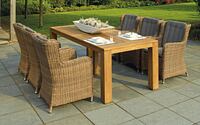A Guide to Designing the Perfect Patio
The luxury of having an outdoor space offers you a relaxing place to reflect and unwind in the privacy of your own home, with the warm rays of the sun on your face and the soothing sounds of bird songs on your doorstep. Designing a patio will not only enhance your enjoyment of your garden but will also increase the value of your home. In this article, we’ve outlined some of the key aspects to consider when it comes to planning your perfect patio design.
Function
Before you can begin the landscape design of your garden, it is important to know the function you want your new patio to perform. For instance, if you plan to use the area to mainly entertain guests, consider how many people you intend to host and the amount and size of patio furniture you will need. On the other hand, if it is meant as a place of solitude for yourself and family members then you will have more space to play around with.
Plan for gaps and negative space on your patio to avoid it feeling cluttered or cumbersome to move through. This will allow enough space for people to move around the patio comfortably. A good way to figure out how much space you might need is to arrange a table and chairs in your garden.
Size
The size of your patio will largely be determined by the available space in your garden and how much of that space you want to redesign. As a general guide, you should take into account the number of people who plan to host and plan for around 25 square feet of space per person. Consider consulting expert patio designers such as Malone’s Landscape to assist you with your patio design.
Patio Zones
An essential part of your garden design is to plan each zone of your patio from the outset. If you intend to create an outdoor dining area as part of your patio design then positioning it close to your kitchen doors is best. Similarly, if you wish to create a zone to relax and sunbathe, then it should allow for maximum sunlight and be surrounded by flowers or other aromatic plants.
Interspersing plants or flowers as borders between different zones can help to soften your patio design by adding elements of nature as well as a touch of color. Ideally, your patio is a private area for you and your family. To maintain this sense of seclusion, take advantage of any trees or fences in your garden when planning your patio.
Materials
When deciding on your choice of materials, it’s a good idea for your patio to reflect the aesthetics of your home’s interior. A modern home, for instance, will blend well with a contemporary design and choice of material such as porcelain, natural stone, or concrete, while a more traditionally decorated home will suit materials from the same period.
If you are considering decking for your patio some of the best hardwood materials include cedar, mahogany, bamboo, and pressure-treated pine.
Follow the four tips in this article to help your patio design project get underway successfully.
- by Matt Watts
